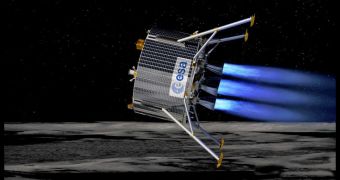Gaining access to water and other volatile resources would be one of the most important first steps that future lunar colonists would need to deal with upon arriving at the Moon. The European Space Agency is planning a new mission to the lunar surface, whose goal would be to pave the way for explorers.
The Lunar Lander spacecraft is a proposed ESA mission, whose purpose would be to search for water and volatile resources at numerous locations all over Earth's natural satellite. Even today, 40 years after we first visited it, the Moon largely remains a mystery to science.
Studies conducted a couple of years ago have demonstrated that water-ice exists in permanently-shadowed craters located at the lunar south pole. However, that region is extremely rugged, and future explorers would have a hard time finding a smooth spot to land their spacecraft on.
In order to solve this problem, ESA plans to launch an unmanned lander, which will automatically make its way to the lunar south pole. It will also be capable of analyzing the ground underneath it, scanning for an appropriate landing location.
“Our ambition is to see one day a European astronaut working on the Moon. It is the mission that will provide Europe with the planetary landing technology of the future,” ESA expert Bruno Gardini says.
The Lunar Lander, a precursor to these efforts, is scheduled to launch around 2018, an ESA press release announces. A meeting to discuss the spacecraft was already held at the ESA European Space Research and Technology Center (ESTEC), in the Netherlands.
At the talks, where Apollo program scientists and engineers also participated, experts discussed issues related to the scientific payload that the mission will carry, as well as the elements that the instruments will need to be able to detect.
These include radiation, dust, habitats and volatiles such as water, carbon, nitrogen, phosphorus or sulfur. According to planetary scientists, the spacecraft is most likely to find these elements at the lunar poles, were water-ice was also identified.
“To analyze the volatiles or the water that is all over the Moon in very small quantities, we have to take samples of the materials we find on the surface and analyze them in situ,” Bruno goes on to say.
“We certainly don’t know where the water comes from until we get down there and do more experiments. That’s why the Lunar Lander is so important,” says Open University professor Colin Pillinger, who used to analyze rock samples brought back by Apollo astronauts.
“I play the devil’s advocate. I’m giving my knowledge about lunar soil, something that I’ve been working on for 40 years. I have a different perspective, so I’m saying to the engineers: are you sure you are going to find this?” adds University of Tennessee scientist and geologist Larry Taylor

 14 DAY TRIAL //
14 DAY TRIAL //